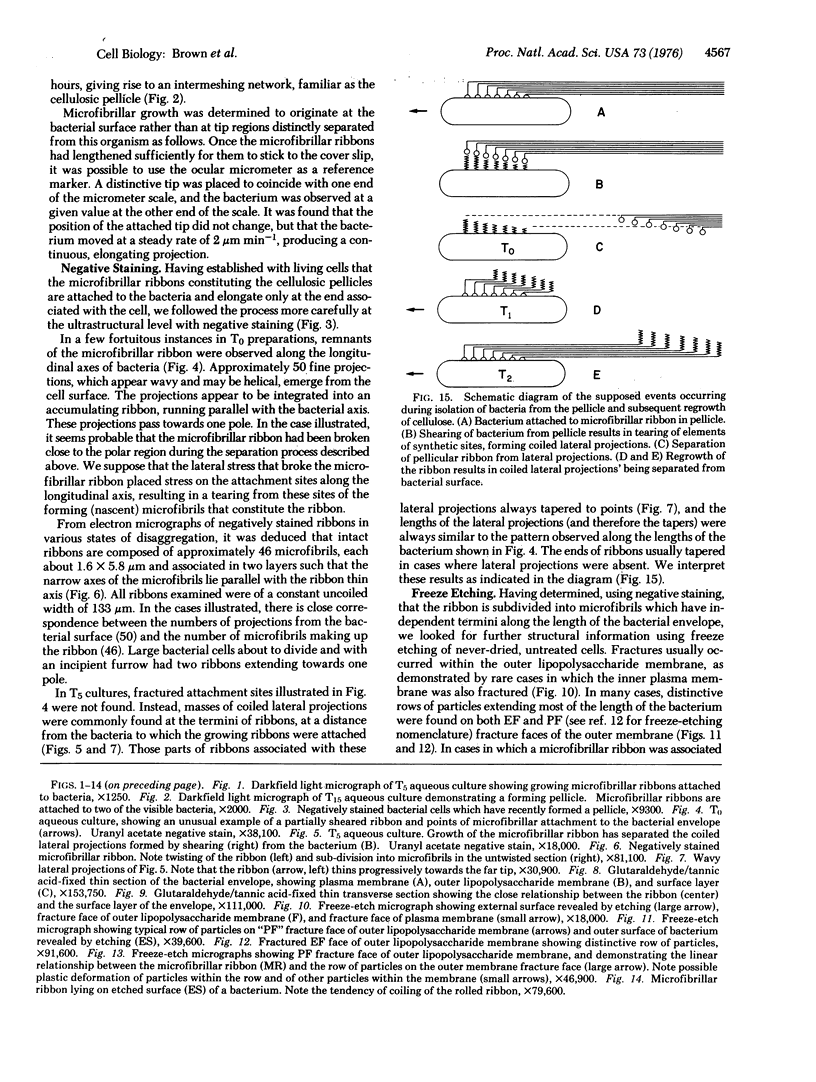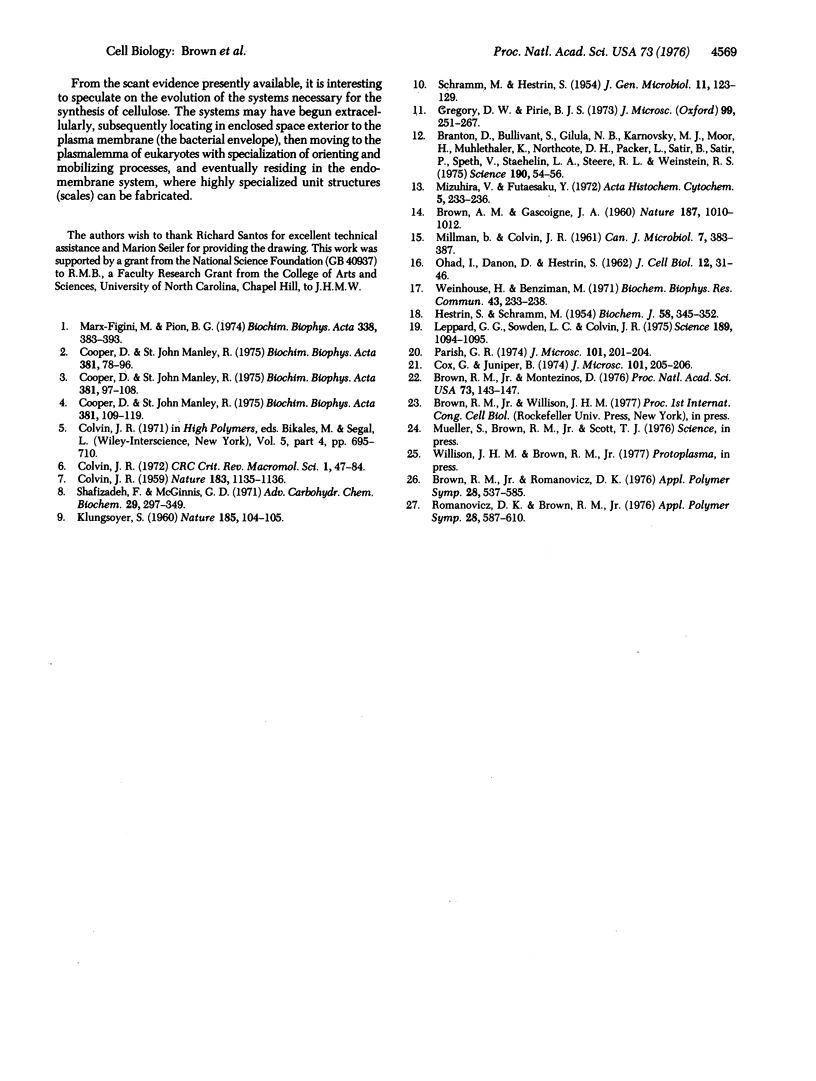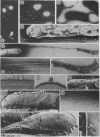Abstract
In vivo synthesis of cellulose by Acetobacter xylinum was monitored by darkfield light microscopy. Cellulose is synthesized in the form of a ribbon projecting from the pole of the bacterial rod. The ribbon elongates at a rate of 2 mum min-1. The ribbon consists of approximately 46 microfibrils which average 1.6 X 5.8 nm in cross section. The observed microfibrillar elongation rate corresponds to 470 amol of glucose/cell per hr assimilated into cellulose. Electron microscopy of the process using negative staining, sectioning, and freeze-etching indicated the presence of approximately 50 individual synthetic sites organized in a row along the longitudinal axis of the bacterial rod and in close association with the outer envelope. The process of cellulose synthesis in Acetobacter is compared with that in eukaryotic plant cells.
Full text
PDF




Images in this article
Selected References
These references are in PubMed. This may not be the complete list of references from this article.
- Branton D., Bullivant S., Gilula N. B., Karnovsky M. J., Moor H., Mühlethaler K., Northcote D. H., Packer L., Satir B., Satir P. Freeze-etching nomenclature. Science. 1975 Oct 3;190(4209):54–56. doi: 10.1126/science.1166299. [DOI] [PubMed] [Google Scholar]
- Brown R. M., Jr, Montezinos D. Cellulose microfibrils: visualization of biosynthetic and orienting complexes in association with the plasma membrane. Proc Natl Acad Sci U S A. 1976 Jan;73(1):143–147. doi: 10.1073/pnas.73.1.143. [DOI] [PMC free article] [PubMed] [Google Scholar]
- COLVIN J. R. Synthesis of cellulose in ethanol extracts of Acetobacter xylinum. Nature. 1959 Apr 18;183(4668):1135–1136. doi: 10.1038/1831135a0. [DOI] [PubMed] [Google Scholar]
- Cooper D., Manley R. S. Cellulose synthesis by Acetobacter xylinum. I. Low molecular weight compounds present in the region of synthesis. Biochim Biophys Acta. 1975 Jan 13;381(1):78–96. doi: 10.1016/0304-4165(75)90191-9. [DOI] [PubMed] [Google Scholar]
- Cooper D., Manley R. S. Cellulose synthesis by Acetobacter xylinum. II. Investigation into the relation between cellulose synthesis and cell envelope components. Biochim Biophys Acta. 1975 Jan 13;381(1):97–108. doi: 10.1016/0304-4165(75)90192-0. [DOI] [PubMed] [Google Scholar]
- Cooper D., Manley R. S. Cellulose synthesis by Acetobacter xylinum. III. Matrix, primer and lipid requirements and heat stability of the cellulose-forming enzymes. Biochim Biophys Acta. 1975 Jan 13;381(1):109–119. doi: 10.1016/0304-4165(75)90193-2. [DOI] [PubMed] [Google Scholar]
- Gregory D. W., Pirie B. J. Wetting agents for biological electron microscopy. II. Shadowing. J Microsc. 1973 Dec;99(3):267–278. doi: 10.1111/j.1365-2818.1973.tb04626.x. [DOI] [PubMed] [Google Scholar]
- HESTRIN S., SCHRAMM M. Synthesis of cellulose by Acetobacter xylinum. II. Preparation of freeze-dried cells capable of polymerizing glucose to cellulose. Biochem J. 1954 Oct;58(2):345–352. doi: 10.1042/bj0580345. [DOI] [PMC free article] [PubMed] [Google Scholar]
- KLUNGSOYR S. Transglucosidase activity in Acetobacter xylinum. Nature. 1960 Jan 9;185:104–105. doi: 10.1038/185104a0. [DOI] [PubMed] [Google Scholar]
- Leppard G. G. Nascent stage of cellulose biosynthesis. Science. 1975 Sep 26;189(4208):1094–1095. doi: 10.1126/science.1162359. [DOI] [PubMed] [Google Scholar]
- MILLMAN B., COLVIN J. R. The formation of cellulose microfibrils by Acetobacter xylinum in agar surfaces. Can J Microbiol. 1961 Jun;7:383–387. doi: 10.1139/m61-046. [DOI] [PubMed] [Google Scholar]
- OHAD I., DANON I. O., HESTRIN S. Synthesis of cellulose by Acetobacter xylinum. V. Ultrastructure of polymer. J Cell Biol. 1962 Jan;12:31–46. doi: 10.1083/jcb.12.1.31. [DOI] [PMC free article] [PubMed] [Google Scholar]
- Parish G. R. The interpretation of freeze-etch replicas from plant cell walls. J Microsc. 1974 Jul;101(Pt 2):201–204. doi: 10.1111/j.1365-2818.1974.tb03883.x. [DOI] [PubMed] [Google Scholar]
- SCHRAMM M., HESTRIN S. Factors affecting production of cellulose at the air/liquid interface of a culture of Acetobacter xylinum. J Gen Microbiol. 1954 Aug;11(1):123–129. doi: 10.1099/00221287-11-1-123. [DOI] [PubMed] [Google Scholar]
- Weinhouse H., Benziman M. Regulation of gluconeogenesis in Acetobacter xylinum by hexoses. Biochem Biophys Res Commun. 1971 Apr 16;43(2):233–238. doi: 10.1016/0006-291x(71)90742-x. [DOI] [PubMed] [Google Scholar]



